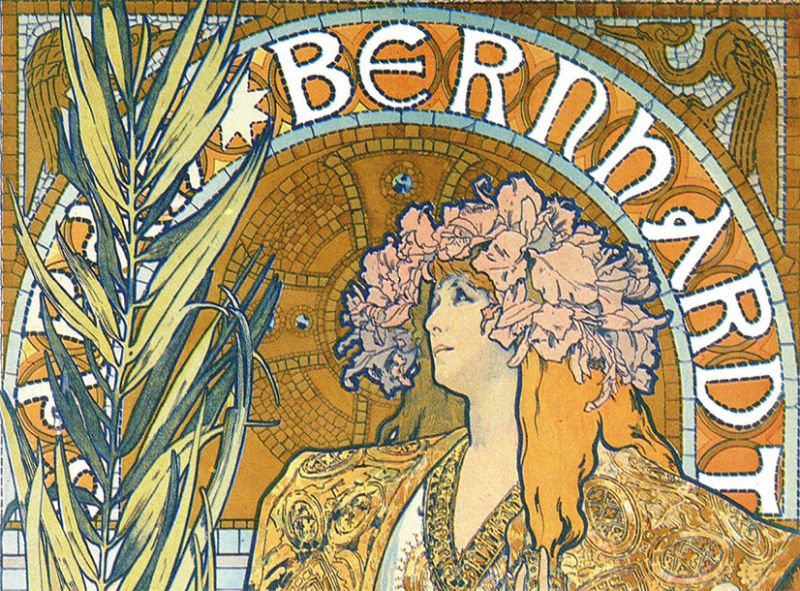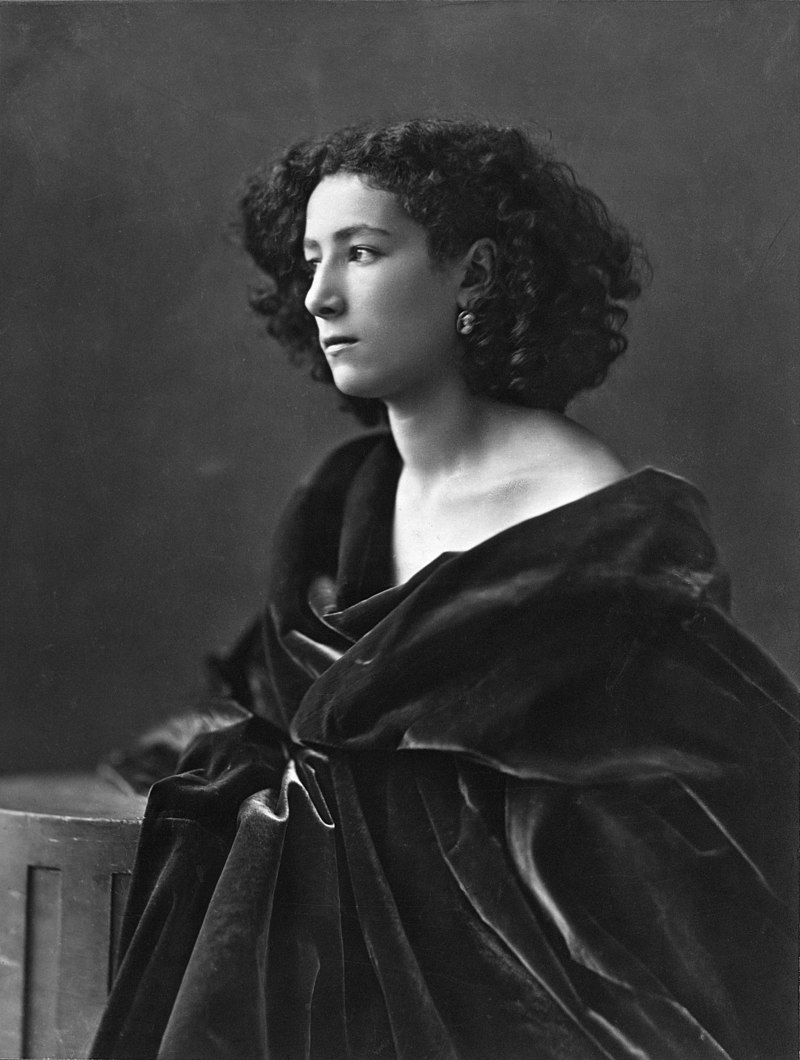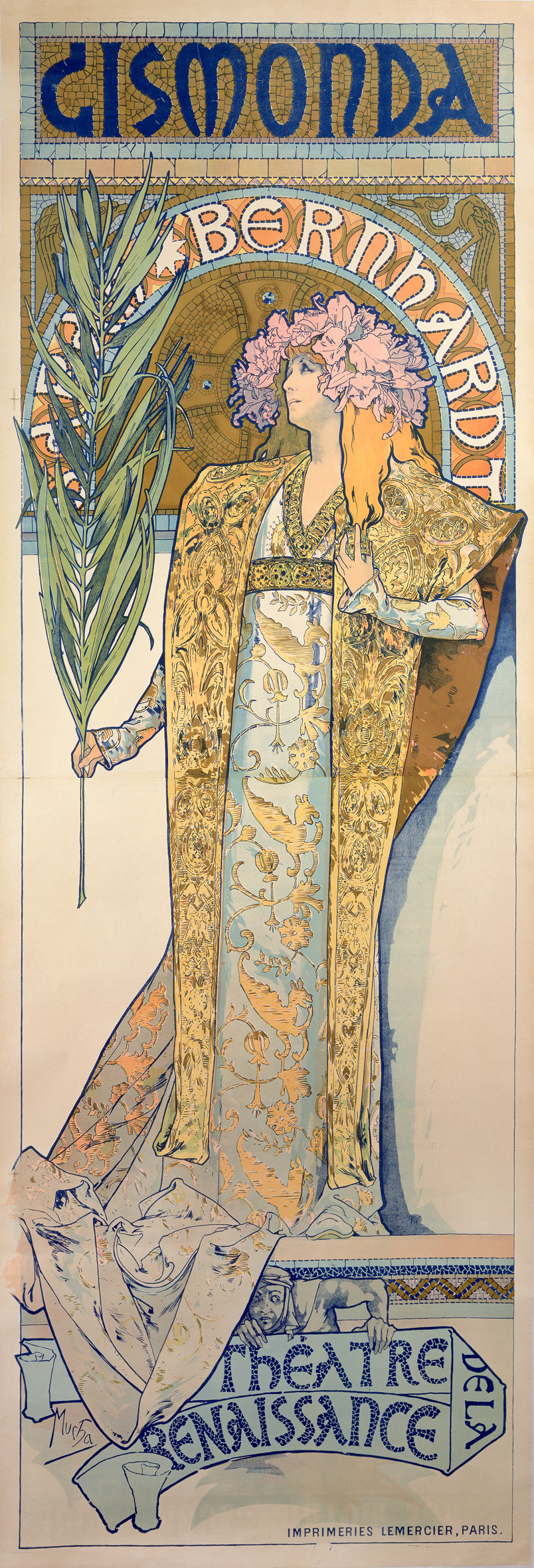
Have you ever immersed yourself in the timeless fascination of the golden age of theatre and art in the late 19th and early 20th century? Today we travel back in time, to the effervescent Paris of the late 19th century, where two emblematic figures crossed paths, creating an artistic union that still fascinates today.
The famous actress Sarah Bernhardt and the artist Alphonse Mucha not only defined the era in which they lived, but created an artistic legacy that continues to inspire.
In this post we discover together the tumultuous life of Sarah Bernhardt and her unforgettable collaboration with Alphonse Mucha.
Sarah Bernhardt and Alphonse Mucha: a timeless link between Theatre and Art

Sarah Bernhardt
Sarah Bernhardt, born as Henriette-Rosine Bernard on 22 October 1844 in Paris, was the daughter of a courtesan and was pushed into the world of acting by the pressures of Parisian society at the time.
Despite her initial aspirations to consecrate herself to religious life, her family and some influential people decided that her destiny would be on the stage. Thus, under the auspices of influential figures such as the Duke of Morny and the playwright Alexandre Dumas, Sarah was introduced to the prestigious Comédie-Française, thus beginning her long and legendary career in theatre.
EARLY CHALLENGES AND THE RISE TO SUCCESS
The road to success was not without obstacles for Sarah. However, thanks to her undeniable talent and the help of influential personalities, she managed to gain a prestigious position in the Parisian theatre world.
Her career took a decisive turn in 1868, when her talent was irrefutably recognised with a legendary performance in a play by Dumas. From then on, her career began to flourish, leading her to star in some of the most challenging plays of the time.
IL LEGAME CON ALPHONSE MUCHA
Sarah Bernhardt‘s talent not only won over the public but also the Czech painter Alphonse Mucha. Their artistic collaboration began in 1895, with the creation of a revolutionary poster for the play ‘Gismonda’.
This poster not only catalysed the attention of the public who flocked to see the play, but also launched Mucha’s career, who succeeded in sublimating Sarah’s femme fatale image. It was the beginning of a collaboration that would see the creation of numerous other works of art, further consolidating the reputation of both in the world of art and theatre.
AN IMMORTAL LEGACY
Sarah Bernhardt was not only a diva of her time, but also a revolutionary icon who transcended social conventions. Her life, enriched and sometimes troubled by a series of emotional and professional relationships, continued to shine even after her transition from theatre to film, where her roles in films such as ‘La Tosca’ and ‘La Dame aux Camelias’ left an indelible mark.
His death in 1923 marked the end of an era, but his legacy lives on through countless performances on stage and screen. However, it is his collaboration with Alphonse Mucha that remains one of the most brilliant examples of how art and theatre can come together, creating something truly magical and timeless.
AUTOBIOGRAPHY OF SARAH BERNHARDT
If Sarah Bernhardt’s public life was inextricably intertwined with the glittering world of the theatre, it is through her memoirs, revealed to the world in 1898 in France and now available in Italian in a complete version, that the actress reveals her private existence. In her autobiography ‘Memories of My Life’, she recounts her exceptional life and describes the artistic and social scene of late 19th century Paris.
It is an authentic narrative, ranging from a turbulent childhood, through touring, to achieving success on an international scale, tracing the trajectory of a decidedly unique life. Sarah astutely uses these memoirs as a tool to sculpt a less ‘divine’ and more earthly image of herself, in which the vicissitudes of fortune, fortuitous encounters, whims, anecdotes, rebellions, refinements, and passion for art converge in a fluid and compelling prose, a long confession that constantly oscillates between sincerity and idealised representation.

Alphonse, Mucha Gismonda
The story of Sarah Bernhardt and Alphonse Mucha is a fascinating journey through art, drama and artistic immortality. A legend that continues to inspire and make us dream, reminding us of the inexhaustible magic of art and theatre.

